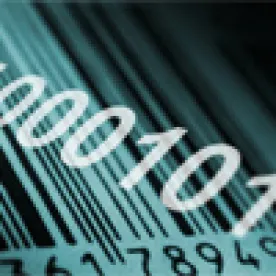When introduced nearly fifty years ago, the Universal Product Code (UPC)—the most visually recognizable of One-Dimensional (1D) barcodes—was a major innovation. 1D barcodes increased checkout speeds, improved accuracy of transactions, and enabled stores to better monitor sales. Now, the Two-Dimensional (2D) barcode offers the potential to transform retail once-again.
In coordination with industry, GS1 US—the nonprofit standards organization that oversees barcodes—launched an initiative dubbed “Sunrise 2027”[1] that aims for retailers to be able to read 2D barcodes at points of sale by the end of 2027. According to GS1 US, 2D barcodes can provide a range of benefits, including improved inventory management, enhanced recall readiness, greater sustainability and ethical sourcing, better product authentication, and greater brand trust.[2] The transition to 2D, however, will also present new challenges and legal risks that companies need to prepare for as they push forward into this new era.
1D Versus 2D
1D barcodes are the familiar pattern of black and white bars organized horizontally that you scan at the self-checkout line of your favorite local retailer. These linear barcodes consist of around two dozen characters, and only contain alphanumeric data. Since these barcodes grow longer with more data, their length is typically limited to around 8-15 characters. The UPC code—printed on virtually every consumer product in the world—only encodes a maximum of 11 numeric digits and a trailing checksum, encoding just two facts: manufacturer and product code.
2D barcodes contain a matrix code that stores information both horizontally and vertically. As a result, 2D barcodes can hold much more data—up to 2,000 characters—while remaining smaller than a 1D barcode. 2D barcodes are also not limited to alphanumeric data and can include references to images, sounds, and other forms of information. For example, QR codes—a type of 2D barcode accessible via smartphone scan that gained popularity during the COVID-19 pandemic—are now commonly used to replace certain paper items, including restaurant menus and product instruction manuals.
The Potential of 2D
Industry and consumers can expect a range of benefits stemming from the growing use of 2D barcodes. For example, 2D barcodes have already helped certain retailers more closely monitor food products. Woolworths Supermarket—the largest supermarket chain in Australia and New Zealand—piloted placing 2D barcodes on fresh meat and poultry products back in 2019.[3] By 2022, barcodes were on 50% of the products in Woolworths’ meat category in over 1,000 of its stores.[4] GS1 Australia estimates that Woolworths can enhance food safety and reduce food waste by up to 40% for products that have fully transitioned to 2D barcodes.[5] 2D barcodes help industry achieve these results by encoding a product’s batch and serial number within the barcodes, helping to limit waste by easily identifying expired or recalled products while allowing unaffected products to remain on the shelf.
Companies can also rely on 2D barcodes to meet government regulations. For example, the Drug Supply Chain Security Act (DSCSA) required the pharmaceutical supply chain to achieve electronic tracing of products at the package level by November 27, 2023.[6] The DSCSA specifies that packages must be marked with a 2D barcode, or homogeneous cases to be marked with either a 2D barcode or linear barcode.[7] Further, the FDA Final Rule on Requirements for Additional Traceability Records for Certain Foods (Food Traceability Final Rule) “establishes traceability recordkeeping requirements, beyond those in existing regulations, for persons who manufacture, process, pack, or hold foods included on the Food Traceability List.”[8] This includes maintaining records containing “Key Data Elements” associated with specific “Critical Tracking Events.”[9] While the compliance date for the Food Traceability Final Rule is not until January 20, 2026,[10] companies must plan ahead to meet the rule’s extensive requirements. 2D barcodes can help—and may in fact be necessary to comply.
2D barcodes can help companies keep consumers informed and safe. Unlike static 1D barcodes, 2D barcodes allow the manufacturer to provide consumers with the most current information by directing them to dynamic webpages. For example, the clothing industry could consider utilizing 2D barcodes to embed the necessary information from long, itchy clothing tags, while also providing consumers with the most current information—including information on the recyclability of products, which is subject to change. Companies could also employ 2D barcodes to alert consumers of product safety issues and recalls. Eventually, 2D barcodes could be the primary mechanism to deliver targeted notices to consumers about product safety issues and recalls affecting specific products.
The increasing ability to collect consumer information through 2D barcodes raises potential data privacy concerns, however. Every time a consumer scans a QR code, metadata regarding the device used, location, IP address, date and time, and other information they may input can be collected.[11] Companies that collect any such consumer information should be aware of the consent requirements for and risks associated with the collection and storage of consumer information and have safeguards in place to give consumers proper notice and prevent data breaches.
The Future in 2D
While 2027 is still several years away, the transition to 2D is already well underway. This shift will require companies to examine their systems and make process changes. Such changes will come with great benefits but also new legal requirements, risks, and challenges that companies must anticipate and prepare for.
Special thanks to Marcella Michalek, a former summer associate at Foley, for her contributions to this article.
FOOTNOTES
[1] A New Dimension in Barcodes: Get Ready for Sunrise 2027, GS1 US, https://www.gs1us.org/industries-and-insights/by-topic/sunrise-2027.
[2] Id.
[3] Woolworths Australia Seeing Multiple Benefits From Barcodes, GS1, 2, https://www.gs1.org/sites/gs1/files/2022-06/case-study-woolworths-gs1australia.pdf.
[4] Id.
[5] Id.
[6] 2023 DSCSA Requirements, PDSA, https://pdsaonline.org/dscsa-information/phase-ii-implementation.
[7] 2019 Update: Barcode Readability for DSCSA 2023 Interoperability, GS1 US, https://www.fda.gov/media/168278/download#:~:text=The%20HDA%20Guidelines%20for%20Bar,encoding%20all%20four%20data%20elements.
[8] FSMA Final Rule on Requirements for Additional Traceability Records for Certain Foods, FDA, https://www.fda.gov/food/food-safety-modernization-act-fsma/fsma-final-rule-requirements-additional-traceability-records-certain-foods#:~:text=The%20FDA%20final%20rule%20on,Food%20Traceability%20List%20(FTL).
[9] Id.
[10] Id.
[11] Security Considerations for QR Codes, Canadian Centre for Cyber Security (Jan. 2022), https://www.cyber.gc.ca/en/guidance/security-considerations-qr-codes-itsap00141.




 />i
/>i

